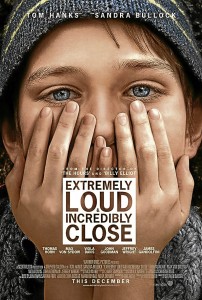
Directed by Stephen Daldry (“The Reader,” “The Hours”), the film has been nominated for Best Picture at this year’s Academy Awards.
In 2005, novelist Jonathan Safran Foer, renowned for his blend of incisive comedy and tragedy in his debut novel, “Everything Is Illuminated,” published his follow-up, “Extremely Loud & Incredibly Close.” His second novel was, on the one hand, the playful story of an unusually precocious and sensitive boy who invents fantastical devices, dreams about astrophysics, collects a vast assortment of random facts—and is compelled into a quixotic odyssey through the fabric of New York. At the same time, the novel was the first major literary exploration into the grief of 9/11 families, and a study of how a child’s imagination helps him navigate overwhelming fear and unfathomable loss.
Subjective
When Daldry read the book, he was struck most of all by Oskar’s subjective point of view. An unusual child with arrestingly high intelligence, eccentric and obsessive behaviors that might put him on the autistic spectrum, Oskar describes the world around him with his own particular mix of naiveté and insight, nervousness and boldness, incomprehension and a need to understand.
Most of all, Daldry was intrigued by how this POV, just like a child’s imagination, combined random thoughts, flashes of memory, lists of ideas and impromptu fantasies with pure emotion—all at a moment when life has irrevocably changed for Oskar’s family and the world around him.
The book wove many themes—of individual and national trauma, of childhood’s strangeness, of the nature of tragedy and the endurance of love through family hardship—into its tapestry. Each of those themes was key to the storytelling, but Roth found his way in through one particular element: the relationship between Oskar and his father, Thomas (Hanks), who is seen in the film entirely through Oskar’s subjective memories, which are, in turn, fueled by a confusing mixture of love, loss and lingering questions.
‘Black’
Oskar deeply misses his father’s so-called “reconnaissance expeditions,” clever puzzles that Thomas created for Oskar to solve, not only as inspired father-son games but also to help him engage with the world despite his social awkwardness. So when he finds the mysterious key in the bottom of a vase hidden in the dark recesses of his father’s closet, Oskar propels himself into a new mission to ferret out the key’s meaning.
His only clue to the key’s potential origins is the name “Black,” written on the envelope in which he found it, so Oskar dutifully makes an ambitious plan to visit all 472 people named Black in the New York City phone books, even though, according to the math, it will take him three years to do so.
“Oskar is a kid who is different, but in a wonderful way,” notes Roth. “He might have a form of Asperger’s but he also has a great imagination and a real sense of curiosity along with his many fears. For a long time, he was kept afloat very much by his father who enjoyed so many similar things. So now, when Oskar finds his father’s key a year after his death, he believes it has to unlock something—a piece of advice, an object, some wisdom that his father left for him. And it leads him on an adventure that is his way of coming to terms with grief and all sorts of other things.”
As Roth began compacting Foer’s wide-ranging plot and finding the cinematic structure, he found Foer to be a supportive resource.
Daldry says: “Jonathan really understands the difference between a book and a script, and was very helpful. He never once uttered the phrase, ‘Well, in the book…’ He was always open to interpretation and reinvention.”
“Extremely Loud & Incredibly Close” opens nationwide Feb. 29.